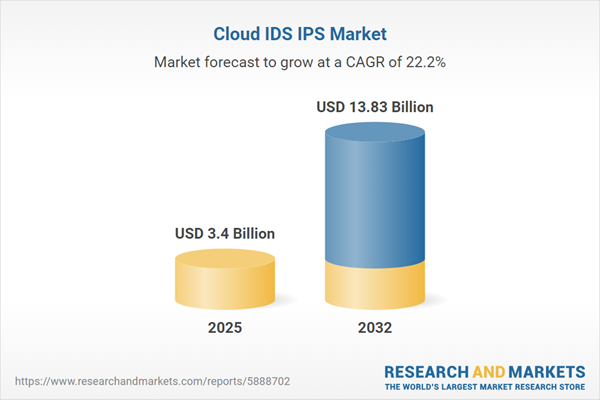Speak directly to the analyst to clarify any post sales queries you may have.
The cloud IDS IPS market plays a pivotal role in organizational security, providing essential tools for risk management, compliance, and enabling ongoing digital transformation initiatives. As businesses advance modernization efforts, these platforms empower leaders to safeguard operations and enhance resilience in complex digital environments.
Market Snapshot: Cloud IDS IPS Market Overview and Growth
The cloud IDS IPS market is demonstrating robust expansion, with a valuation of USD 2.77 billion in 2024, projected to reach USD 3.40 billion by 2025 and USD 13.83 billion by 2032. Growth is fueled by widespread migration to cloud-based infrastructures and increasing reliance on hybrid IT frameworks. Integrated cybersecurity needs, driven by compliance pressures and advancing regulatory requirements, continue to influence procurement decisions and solution adoption. The demand for platforms that enable rapid threat detection and adaptive response is evident, with solutions becoming integral to enterprise security frameworks. This aligns with heightened regulatory mandates, operational complexity, and the ongoing evolution of digital business landscapes.
Scope & Segmentation of the Cloud IDS IPS Market
- Deployment Modes: Public, private, and hybrid clouds support integration with existing on-premises architecture, delivering flexibility for different risk and compliance profiles.
- Component Types: Services include managed security, consulting, as well as hardware, software, and both host-based and network-based IDS IPS. Approaches blend signature and anomaly detection, enabling adaptability to dynamic threat environments and compliance standards.
- End User Verticals: Finance, government, healthcare, IT, telecom, and retail sectors employ tailored solutions to address transparency, sector regulations, and data protection, fostering trust among key stakeholders.
- Organization Sizes: Offerings are scalable for both global enterprises and smaller firms, accommodating varying levels of IT capacity, security maturity, and resource availability.
- Regions: Adoption spans the Americas, Europe, Middle East, Africa, and Asia-Pacific, with each region influenced by unique regulatory mandates, procurement approaches, and digital transformation objectives.
- Key Companies: Leading vendors such as Palo Alto Networks, Cisco Systems, Fortinet, Check Point Software Technologies, Trend Micro, IBM, Juniper Networks, McAfee, FireEye, and Radware drive innovation, promote integration, and shape industry standards.
Recognizing these segments empowers decision-makers to allocate resources effectively, meet evolving compliance demands, and tailor cybersecurity strategies to geographic and sector-specific requirements.
Key Takeaways for Senior Decision-Makers
- Centralized management streamlines the governance of distributed assets, improving oversight as organizations modernize operations and migrate workloads.
- AI and machine learning integration advance detection capabilities, supporting rapid response and proactive risk mitigation for complex, evolving threats.
- Implementation of zero trust frameworks and granular access controls reduces attack surfaces within both cloud and hybrid environments.
- Managed and hybrid models simplify regulatory compliance, minimize audit cycles, and support operational scalability, even as organizations adapt or grow.
- Advanced analytics enable continuous recalibration of security strategies to align with changing threat landscapes, guiding technology investments and enhancing detection capabilities.
- Cloud-native IDS IPS extends high-level security management to smaller enterprises, simplifying administration while upholding security standards.
Tariff Impact: Geopolitical and Supply Chain Considerations
Recent US hardware tariffs have raised acquisition expenses, prompting a shift toward software-defined and cloud-native IDS IPS platforms. This transition encourages broader adoption of hybrid deployment models and diversification of supply networks. By prioritizing software-driven solutions and expanding sources, organizations bolster operational resilience, minimize risks from supply chain interruptions, and better manage global sourcing uncertainties.
Methodology & Data Sources
This research synthesizes direct interviews with cybersecurity executives, official data sets from industry leaders, and comprehensive reviews from subject matter experts. External regulatory review and independent sector analysis further support the accuracy and relevance of all findings for strategic planning.
Why This Report Matters
- Empowers executives to direct cloud IDS IPS investments that align with business modernization and compliance priorities.
- Offers actionable segmentation by sector and region, supporting informed procurement and comprehensive risk management in varied regulatory environments.
- Facilitates executive planning by addressing critical drivers—from compliance evolution and technology shifts to supply chain complexities—reinforcing organizational resilience.
Conclusion
Cloud IDS IPS solutions support adaptive, compliant security frameworks that strengthen enterprise agility. This report gives leaders clear guidance for navigating rapidly changing digital and regulatory challenges.
Additional Product Information:
- Purchase of this report includes 1 year online access with quarterly updates.
- This report can be updated on request. Please contact our Customer Experience team using the Ask a Question widget on our website.
Table of Contents
3. Executive Summary
4. Market Overview
7. Cumulative Impact of Artificial Intelligence 2025
Companies Mentioned
The companies profiled in this Cloud IDS IPS market report include:- Palo Alto Networks, Inc.
- Cisco Systems, Inc.
- Fortinet, Inc.
- Check Point Software Technologies Ltd.
- Trend Micro Incorporated
- International Business Machines Corporation
- Juniper Networks, Inc.
- McAfee LLC
- FireEye, Inc.
- Radware Ltd.
Table Information
| Report Attribute | Details |
|---|---|
| No. of Pages | 198 |
| Published | October 2025 |
| Forecast Period | 2025 - 2032 |
| Estimated Market Value ( USD | $ 3.4 Billion |
| Forecasted Market Value ( USD | $ 13.83 Billion |
| Compound Annual Growth Rate | 22.2% |
| Regions Covered | Global |
| No. of Companies Mentioned | 11 |









